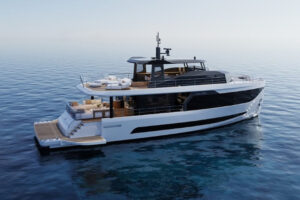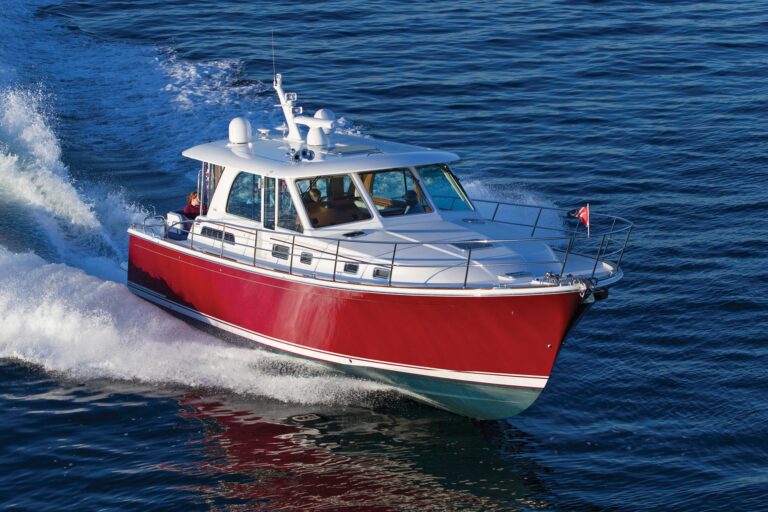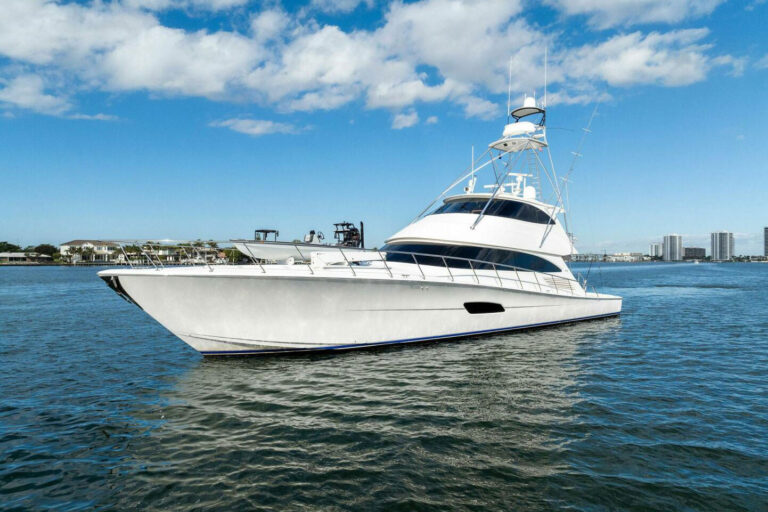Pursuit built its brand with the belief that fishermen would pay a bit more for increased quality and performance. The success of the builder’s line of boats from 22 to 38 feet has proven Pursuit worthy of the niche it helped carve out. Following this path, Pursuit has launched the 3370 Offshore, its largest outboard-powered boat to date.
Until recently, a 33-foot, 4-inch boat with a 10-foot, 6-inch beam weighing more than 10,000 pounds would not have been a reasonable candidate for outboard power. Times have changed, and Pursuit is one of a growing number of mainstream production builders that is taking advantage of the efficient outboard technology that has come about in the last few years.
I tested the 3370, fitted with a pair of 300 hp two-stroke Yamaha HPDIs (high-pressure direct injection). I recorded a maximum speed of 41.9 knots at 5300 rpm. The 3370 is also available with a pair of 225 hp Yamaha four-strokes. Pursuit’s data suggests the four-strokes are a bit less thirsty, but this advantage comes at a cost: a maximum speed of 38 knots (6000 rpm). It’s a tough choice, particularly when you factor in the quiet four-stroke ride. Pursuit noted 88.9 decibels at full throttle. I recorded 96 decibels at full throttle with the two-strokes. Toss in the added cost of two-stroke oil or the four-stroke’s more relaxed acceleration, and you’ve got the makings of a real dockside debate.
I would choose the two-strokes solely for the extra knots. Speed is one of the primary assets of a small sportfishing platform. If you are not interested in chasing the sailfish bite, or if you fish the Bahamas (where fuel is particularly dear), I suggest the four-stroke option. In either case, a generous 310-gallon fuel tank is standard. An additional 34-gallon tank is available but is not necessary unless you have a specific long-range goal in mind.
Though big-boat guys might scoff at compact fishing machines, fact is, a fast, agile, small boat with skilled anglers aboard can be a serious tournament player when properly designed. Pursuit knows this and rigs its boats accordingly. Standard fishing features include rodholders, fresh- and raw-water washdowns (there is also a sink) and a transom tackle center with a cutting board, and a tool and rig holder. A transom door allows access to the integral motor well/platform. The insulated in-sole fishbox can be removed for cleaning and access to the bilge area.
The integral transom livewell of the 3370 is of particular interest in that it was developed with the help of Harbor Branch Oceanographic Institution. Harbor Branch is well known for its work in ocean engineering and marine science, and is based in Fort Pierce, Florida, where the 3370 is built. In addition to offering a typical raw-water circulation system, the livewell makes it possible to isolate and aerate an offshore water supply. This increases the likelihood bait will survive a bit longer when the boat returns to dirty water dockside. This feature and the 45-gallon livewell’s shape, clear acrylic top and light-blue color are designed to keep bait alive significantly longer.
Pursuit’s optional Sportfish Group includes 23-foot Rupp outriggers. Tackle drawers are offered in lieu of an icemaker or the standard stowage. Since there is already a bank of tackle drawers at the transom, I would probably opt for the icemaker. A foldaway seat across the transom and two aft-facing fold-away seats can be easily tucked out of the way when you’re fishing.
The 3370’s silhouette, which follows the theme set by other new models in the line, is highlighted by an epoxy/fiberglass windshield frame. The helm is well positioned for keeping an eye ahead and an eye on the cockpit. The control console has enough space for both a 10- and a 7-inch electronic display, as well the usual assortment of smaller goodies. The console can be tilted back for access to wiring.
The ladder-back helm seat swivels and has an adjustable footrest. A tournament-style cast-aluminum wheel is standard. The L-shape companion seating, to port, is sized so the first mate can rest her feet. The standard fiberglass hardtop incorporates an overhead stowage/radio box, is fitted with rodholders and has a mounting plate for radar. Two hatches provide ventilation. Adding the Weather Group’s canvas and curtain package creates a comfortable all-weather helm-windshield wipers and washers are standard.
One of the benefits of outboard power was that it allowed Pursuit designers the space for a large fishing cockpit as well as the interior volume for an amidships cabin, tucked beneath the raised bridge area. A sliding acrylic companionway door, fitted with a screen, leads below. The galley, to port, is equipped with a sink, a single burner cooktop, a microwave and dual-voltage refrigeration. The enclosed head has a shower fixture and VacuFlush system.
The starboard settee and teak table convert to a berth. A diagonal double berth is forward. The midcabin has a reading light, as well as a port for natural lighting and ventilation. Pursuit’s literature suggests accommodations for six. While this is feasible, weekending for a couple with two kids is a more sensible goal. Several interior fabric packages are offered, and all are complemented by teak trim and a teak-and-maple sole.
Those serious about comfort should consider opting for the Deluxe/Comfort Group, which includes a 7,000-BTU air conditioner, an upgraded stereo system with a CD changer and a 15-inch flat screen TV. While a water heater is standard, don’t forget to add the optional dockside water connection. I would also add the 5kW generator (diesel or gas); the diesel package includes a 15-gallon tank. Personally, I would sleep better with the diesel option.
Pursuit has earned its lofty position in the market on the production line, with high-quality tooling and construction. The 3370’s hull is hand laminated with multidirectional knitted fiberglass reinforcement. A blister-resistant vinylester resin is used on the hull below the waterline. Balsa coring is used in the hull sides and decks. A network of internal stiffeners is built of fiberglass and filled with foam. The hull and superstructure/deck cap are mechanically fastened and bonded with adhesive. The 3370’s gelcoat-finished hull is available in several colors, including Pursuit’s “oyster white.” As I have come to expect from Pursuit, our test boat’s fit and finish were well above average.
In my view, the 3370 is proof Pursuit’s market vision is still 20/20. She is a hybrid of sorts, with many of the features of her larger inboard sisters and the convenience of outboard power. She could easily reside off-duty on a boatlift or serve as a holiday base of operations in the Bahamas. If this relatively hassle-free style of boat ownership appeals to you, the 3370 is worthy of your attention.
Contact: Pursuit Boats, (772) 465-6006; www.pursuitboats.com. For more information, contact: (866) 922-4877; www.yachtingnet.com/yachting/productinfo.








